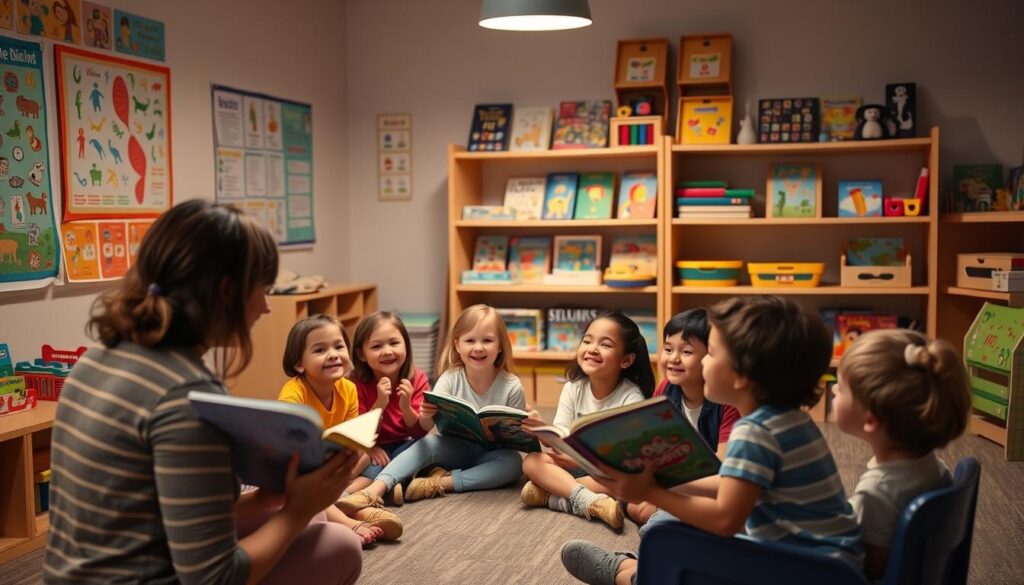Have you ever wondered how some children seem to pick up language skills with ease, while others struggle? The answer may lie in the ancient art of storytelling.
As a parent or educator, you’ve likely used stories to captivate and educate children. But did you know that this timeless tradition is backed by science? Research shows that storytelling stimulates areas of the brain responsible for understanding language and comprehending complex concepts.
Through interactive storytelling, children are not just passive listeners; they become active participants in a world of words, ideas, and emotions. This engagement is crucial for language acquisition and retention, making it a powerful tool for children’s development.
In this article, we’ll explore the multifaceted benefits of storytelling for children, from expanding their vocabulary to fostering emotional intelligence. You’ll discover practical guidance on how to harness the power of interactive storytelling to support the language development of the children in your care.
The Magic of Interactive Storytelling for Children’s Language Growth
The art of storytelling has been a cornerstone of human connection, and when done interactively, it becomes a potent catalyst for children’s language growth. Interactive storytelling captivates children’s attention in a way that few other activities can. When we tell a story, we’re not just speaking words; we’re painting pictures in the minds of our listeners. This visualisation process is incredibly engaging for kids and stimulates their imagination, encouraging them to create mental images of the characters and settings.
What Makes Storytelling “Interactive”?
Interactive storytelling involves a two-way communication process where the storyteller is responsive to the child’s reactions and encourages the child to contribute to the narrative. This can be achieved through various interactive elements such as questions, sound effects, movements, and character voices, transforming a simple story into an immersive language learning experience. For more insights on language development through storytelling, you can visit this resource.
The Natural Connection Between Stories and Language
Storytelling naturally mirrors the way children learn language in real life—through context, repetition, and emotional connection. This makes it an intuitive approach to language development. The narrative structures in stories also have a biological and psychological connection to how our brains process and retain language, making stories more memorable than isolated vocabulary lessons.
The Science Behind Interactive Storytelling Language Development
Interactive storytelling is a powerful tool for enhancing language development in children. Through the act of storytelling, young minds grasp language nuances, syntax, and semantics more effectively than through rote learning.
How Stories Stimulate Brain Development
Stories stimulate areas of the brain responsible for understanding language, comprehending concepts, and imagining realities. The narrative format activates multiple areas of the brain simultaneously, creating rich neural pathways that enhance language processing and retention. This process triggers the release of chemicals like oxytocin and dopamine, crucial for attention and memory formation.
Research Supporting Storytelling as a Language Tool
Research shows that storytelling significantly improves vocabulary, comprehension, and expressive language skills in children. Studies comparing rote vocabulary learning to contextual story-based learning highlight the advantages of the latter for long-term retention and practical language learning. By bridging the gap between receptive and expressive language skills, storytelling provides models for communication that children can incorporate into their own language repertoire.
Key Benefits of Interactive Storytelling for Language Skills
Interactive storytelling offers a unique approach to fostering language skills in young learners. By engaging children in the storytelling process, we can help them develop essential language abilities in a fun and engaging way.
Vocabulary Expansion and Retention
Interactive storytelling naturally introduces new vocabulary in meaningful contexts, making words more memorable for children. The repetitive elements in stories reinforce language patterns and vocabulary, supporting retention through enjoyable repetition.
Improved Comprehension and Listening Skills
Active listening during storytelling develops crucial comprehension skills as children learn to follow narrative arcs and understand cause and effect. This engagement enhances their ability to anticipate what might happen next in the story.
Enhanced Expression and Communication
Interactive storytelling encourages children to express themselves through questions, predictions, and contributions to the story. This participation builds confidence in their communication abilities and exposes them to complex language structures and varied sentence patterns.

Age-Appropriate Storytelling Techniques
As a parent, you’re likely aware that storytelling is a powerful tool for your child’s language development, but did you know that tailoring your approach to their age can make a significant difference? By adapting your storytelling techniques to your child’s age, you can maximize the benefits for their language skills.
For Babies and Toddlers (0-3 years)
For babies (0-1 year), soft, melodic storytelling with lots of facial expressions and gentle gestures is ideal. This captivates their attention and introduces them to the rhythm and sounds of language. As they grow into toddlers (1-3 years), interactive storytelling with simple, repetitive phrases encourages them to join in, helping them predict what comes next.
For Preschoolers (3-5 years)
Preschoolers benefit from vivid imagery, character voices, and props that bring stories to life. Using picture books and puppets can enhance engagement, while strategies like asking questions and providing fill-in-the-blank opportunities encourage participation. For more information on effective storytelling methods, you can explore resources like how to tell a bedtime story.
For Early School Age Children (5-8+ years)
For school-age children, incorporating questions, predictions, and moral lessons into storytelling can be particularly effective. Focusing on more complex narratives and character development, and allowing children to co-create stories or add alternative endings, can help develop critical thinking skills and build empathy.
Practical Interactive Storytelling Activities for Parents
As a parent, you have the power to spark your child’s imagination through interactive storytelling activities. Engaging in storytelling with your child can be a fun and effective way to enhance their language skills. Here are some practical activities you can try:
Creating Stories Together
Start by telling stories together. You can begin a story and ask your child to continue it, making it a collaborative effort. Use prompts like pictures or objects to spark their creativity. For example, you can say, “Once upon a time, in a deep, dark forest…” and let your child fill in the rest.
Using Props and Visual Aids
Using props and visual aids can make storytelling a multi-sensory experience. You can use household items to create a story. For instance, you can use a toy rabbit to act out a story about a rabbit’s adventure. This approach supports different learning styles and reinforces vocabulary through visual and tactile connections.
Incorporating Questions and Dialogue
Incorporating questions and dialogue into your stories can deepen comprehension and encourage critical thinking. Ask your child questions about the story, such as “What do you think will happen next?” or “How do you think the character feels?” This helps to develop their language skills and encourages them to express their ideas.

Building a Language-Rich Environment Through Stories
By incorporating stories into your daily routines, you can create a nurturing environment that fosters your child’s language development. This doesn’t require extra effort, just a little intentionality in your daily interactions.
Establishing Storytelling Routines
Establishing consistent storytelling routines helps children anticipate and look forward to these moments, creating a positive association with language and literacy activities. Bedtime stories, for instance, become a special bonding ritual. You can also weave stories into morning conversations or during meals, making language feel exciting and accessible.
Balancing Digital and Traditional Storytelling
While traditional storytelling is core to language growth, digital tools offer new ways to support this journey. Age-appropriate story apps, interactive stories, and audiobooks can complement your storytelling routine. The key is finding a balance that works for your family, ensuring that screen-based and traditional storytelling methods enhance each other.
Conclusion: Nurturing Lifelong Language Skills Through the Power of Stories
Interactive storytelling emerges as a potent tool in fostering a strong foundation for lifelong language skills. By engaging in this natural and enjoyable approach, parents can help their children develop robust language skills that extend beyond vocabulary to include critical thinking and emotional intelligence.
At The T.E.A. Center and Little Scholars, we believe in the transformative power of storytelling. It’s not just about reading; it’s about creating a journey of language growth that fosters empathy, understanding, and a lifelong love of learning. We encourage you to begin or enhance your storytelling journey with your children, making every story shared an investment in their language future.
FAQ
How can I make storytelling a part of my child’s daily routine?
You can start by setting aside a specific time each day, like before bedtime, to read or tell stories together. Make it a cozy experience by snuggling up and using inflection and expression to bring the story to life!
What are some engaging ways to encourage my child to participate in storytelling?
Try asking your child questions about the story, like “What do you think will happen next?” or “How do you think the character is feeling?” You can also encourage them to predict what might happen next or to create their own stories.
Are picture books suitable for older children?
Absolutely! Picture books can be enjoyed by children of all ages. They often contain complex themes and beautiful illustrations that can spark meaningful conversations and inspire creativity, regardless of your child’s age.
How can I use storytelling to help my child overcome their fears?
Storytelling can be a powerful tool for helping children face their fears. You can create stories that feature characters who overcome similar fears, or use stories to talk about and process difficult emotions together.
Can I use digital tools for storytelling, or is traditional storytelling better?
Both digital and traditional storytelling have their own benefits. Digital tools can offer engaging animations and sound effects, while traditional storytelling can provide a more tactile and personal experience. You can mix and match to find what works best for your child!
How can I assess the impact of storytelling on my child’s language skills?
You can observe your child’s ability to express themselves, understand complex stories, and engage in conversations. You can also notice their enthusiasm for reading and storytelling, and how it evolves over time.




